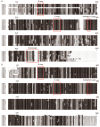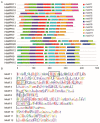Expression Profiling of Mitogen-Activated Protein Kinase Genes Reveals Their Evolutionary and Functional Diversity in Different Rubber Tree (Hevea brasiliensis) Cultivars
- PMID: 28984837
- PMCID: PMC5664111
- DOI: 10.3390/genes8100261
Expression Profiling of Mitogen-Activated Protein Kinase Genes Reveals Their Evolutionary and Functional Diversity in Different Rubber Tree (Hevea brasiliensis) Cultivars
Abstract
Rubber tree (Heveabrasiliensis) is the only commercially cultivated plant for producing natural rubber, one of the most essential industrial raw materials. Knowledge of the evolutionary and functional characteristics of kinases in H. brasiliensis is limited because of the long growth period and lack of well annotated genome information. Here, we reported mitogen-activated protein kinases in H.brasiliensis (HbMPKs) by manually checking and correcting the rubber tree genome. Of the 20 identified HbMPKs, four members were validated by proteomic data. Protein motif and phylogenetic analyses classified these members into four known groups comprising Thr-Glu-Tyr (TEY) and Thr-Asp-Tyr (TDY) domains, respectively. Evolutionary and syntenic analyses suggested four duplication events: HbMPK3/HbMPK6, HbMPK8/HbMPK9/HbMPK15, HbMPK10/HbMPK12 and HbMPK11/HbMPK16/HbMPK19. Expression profiling of the identified HbMPKs in roots, stems, leaves and latex obtained from three cultivars with different latex yield ability revealed tissue- and variety-expression specificity of HbMPK paralogues. Gene expression patterns under osmotic, oxidative, salt and cold stresses, combined with cis-element distribution analyses, indicated different regulation patterns of HbMPK paralogues. Further, Ka/Ks and Tajima analyses suggested an accelerated evolutionary rate in paralogues HbMPK10/12. These results revealed HbMPKs have diverse functions in natural rubber biosynthesis, and highlighted the potential possibility of using MPKs to improve stress tolerance in future rubber tree breeding.
Keywords: Hevea brasiliensis; abiotic stress; functional diversity; gene family evolution; mitogen-activated protein kinase; natural rubber biosynthesis.
Conflict of interest statement
The authors declare no conflicts of interest.
Figures









Similar articles
-
Genome-wide identification of the regulatory network of mitogen-activated protein kinase signaling cascades gene families in Hevea Brasiliensis.BMC Plant Biol. 2025 May 2;25(1):581. doi: 10.1186/s12870-025-06615-6. BMC Plant Biol. 2025. PMID: 40316909 Free PMC article.
-
Calcium-Dependent Protein Kinase Family Genes Involved in Ethylene-Induced Natural Rubber Production in Different Hevea brasiliensis Cultivars.Int J Mol Sci. 2018 Mar 22;19(4):947. doi: 10.3390/ijms19040947. Int J Mol Sci. 2018. PMID: 29565813 Free PMC article.
-
Transcriptome sequencing and comparative analysis reveal long-term flowing mechanisms in Hevea brasiliensis latex.Gene. 2015 Feb 10;556(2):153-62. doi: 10.1016/j.gene.2014.11.048. Epub 2014 Nov 26. Gene. 2015. PMID: 25431836
-
Advances in Genome Sequencing and Natural Rubber Biosynthesis in Rubber-Producing Plants.Curr Issues Mol Biol. 2023 Nov 21;45(12):9342-9353. doi: 10.3390/cimb45120585. Curr Issues Mol Biol. 2023. PMID: 38132431 Free PMC article. Review.
-
Somatic Embryogenesis as Key Technology for Shaping the Rubber Tree of the Future.Front Plant Sci. 2018 Dec 4;9:1804. doi: 10.3389/fpls.2018.01804. eCollection 2018. Front Plant Sci. 2018. PMID: 30564265 Free PMC article. Review.
Cited by
-
Genome-Wide Identification and Characterization of the JAZ Gene Family in Rubber Tree (Hevea brasiliensis).Front Genet. 2019 May 1;10:372. doi: 10.3389/fgene.2019.00372. eCollection 2019. Front Genet. 2019. PMID: 31118943 Free PMC article.
-
Comparative Proteomic Analysis of Molecular Differences between Leaves of Wild-Type Upland Cotton and Its Fuzzless-Lintless Mutant.Molecules. 2019 Oct 19;24(20):3769. doi: 10.3390/molecules24203769. Molecules. 2019. PMID: 31635060 Free PMC article.
-
Evolutionary Analysis of Calcium-Dependent Protein Kinase in Five Asteraceae Species.Plants (Basel). 2019 Dec 24;9(1):32. doi: 10.3390/plants9010032. Plants (Basel). 2019. PMID: 31878291 Free PMC article.
-
A Cotton (Gossypium hirsutum) Myo-Inositol-1-Phosphate Synthase (GhMIPS1D) Gene Promotes Root Cell Elongation in Arabidopsis.Int J Mol Sci. 2019 Mar 11;20(5):1224. doi: 10.3390/ijms20051224. Int J Mol Sci. 2019. PMID: 30862084 Free PMC article.
-
The Class III Peroxidase (POD) Gene Family in Cassava: Identification, Phylogeny, Duplication, and Expression.Int J Mol Sci. 2019 Jun 3;20(11):2730. doi: 10.3390/ijms20112730. Int J Mol Sci. 2019. PMID: 31163686 Free PMC article.
References
-
- Yamashita S., Yamaguchi H., Waki T., Aoki Y., Mizuno M., Yanbe F., Ishii T., Funaki A., Tozawa Y., Miyagi-Inoue Y., et al. Identification and reconstitution of the rubber biosynthetic machinery on rubber particles from Hevea brasiliensis. eLife. 2016;5:19022. doi: 10.7554/eLife.19022. - DOI - PMC - PubMed
LinkOut - more resources
Full Text Sources
Other Literature Sources

